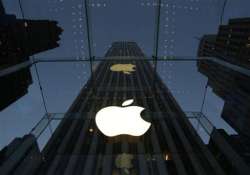Pressure mounts for Apple to expand its horizons
San Francisco: Apple reshaped technology and society when Steve Jobs unveiled the iPhone seven years ago. Now, the trend-setting company is losing ground to rivals that offer what Apple has stubbornly refused to make: smartphones

San Francisco: Apple reshaped technology and society when Steve Jobs unveiled the iPhone seven years ago. Now, the trend-setting company is losing ground to rivals that offer what Apple has stubbornly refused to make: smartphones with lower prices and larger screens than the iPhone.
The void in Apple's lineup is a major reason why the company's quarterly revenue may be about to fall for the first time in more than a decade, much to the dismay of investors who are worried that Apple Inc. is losing its verve and vision.
Wall Street vented its frustration after Apple reported late Monday that it sold fewer iPhones than analysts anticipated during the holiday season. Apple compounded that disappointment with a forecast raising the possibility of a slight revenue decline in the current quarter. It would be the first time that Apple's quarterly revenue has dropped from the previous year since 2003.
Apple's stock shed $44, or 8 percent, to close Tuesday at $506.50, marking the company's largest one-day drop in a year. The sell-off leaves the stock about 28 percent below its peak of $705.07, reached in September 2012 when Apple's leadership in smartphones and tablet computers was still generating robust revenue growth.
Since then, Apple has been relinquishing market share to Samsung Electronics Inc. and other companies that primarily make devices running Google Inc.'s Android operating system. Those competitors offer a broader selection of designs and prices than the iPhone and the iPad.
That trend is one of the reasons that Apple's revenue growth hasn't exceeded 6 percent in any of the past three quarters. By contrast, Apple's quarterly revenue was consistently increasing by at least 20 percent two years ago and even exceeded 70 percent during the 2011 holiday quarter.
Apple remains in stellar shape financially, coming off a $13 billion profit in its most recent quarter - more than all but a handful of companies make in an entire year. The Cupertino, Calif., company also is sitting on nearly $159 billion in cash.
But Apple's stock is unlikely to bounce back to its previous high unless the company's growth accelerates.
The challenges facing Apple have been most glaring in the smartphone market.
Phones in less affluent parts of the world are selling for less than $200. By comparison, iPhones sold for an average of $637 in Apple's most recent quarter. Even Apple's cheaper iPhone 5C is just $100 less than the high-end 5S.
Meanwhile, a variety of Android phones boast screens measuring 5 to 6.5 inches diagonally, while the latest iPhones are all 4 inches.
Apple's insistence on catering to the upper end of the smartphone market with only one choice of screen size is undercutting the company's growth, International Data Research analyst Ramon Llamas said.
"There is a gap where Apple is not playing, and it's clear that many users want some of these other things in a phone," Llamas said.
The void in Apple's lineup is a major reason why the company's quarterly revenue may be about to fall for the first time in more than a decade, much to the dismay of investors who are worried that Apple Inc. is losing its verve and vision.
Wall Street vented its frustration after Apple reported late Monday that it sold fewer iPhones than analysts anticipated during the holiday season. Apple compounded that disappointment with a forecast raising the possibility of a slight revenue decline in the current quarter. It would be the first time that Apple's quarterly revenue has dropped from the previous year since 2003.
Apple's stock shed $44, or 8 percent, to close Tuesday at $506.50, marking the company's largest one-day drop in a year. The sell-off leaves the stock about 28 percent below its peak of $705.07, reached in September 2012 when Apple's leadership in smartphones and tablet computers was still generating robust revenue growth.
Since then, Apple has been relinquishing market share to Samsung Electronics Inc. and other companies that primarily make devices running Google Inc.'s Android operating system. Those competitors offer a broader selection of designs and prices than the iPhone and the iPad.
That trend is one of the reasons that Apple's revenue growth hasn't exceeded 6 percent in any of the past three quarters. By contrast, Apple's quarterly revenue was consistently increasing by at least 20 percent two years ago and even exceeded 70 percent during the 2011 holiday quarter.
Apple remains in stellar shape financially, coming off a $13 billion profit in its most recent quarter - more than all but a handful of companies make in an entire year. The Cupertino, Calif., company also is sitting on nearly $159 billion in cash.
But Apple's stock is unlikely to bounce back to its previous high unless the company's growth accelerates.
The challenges facing Apple have been most glaring in the smartphone market.
Phones in less affluent parts of the world are selling for less than $200. By comparison, iPhones sold for an average of $637 in Apple's most recent quarter. Even Apple's cheaper iPhone 5C is just $100 less than the high-end 5S.
Meanwhile, a variety of Android phones boast screens measuring 5 to 6.5 inches diagonally, while the latest iPhones are all 4 inches.
Apple's insistence on catering to the upper end of the smartphone market with only one choice of screen size is undercutting the company's growth, International Data Research analyst Ramon Llamas said.
"There is a gap where Apple is not playing, and it's clear that many users want some of these other things in a phone," Llamas said.